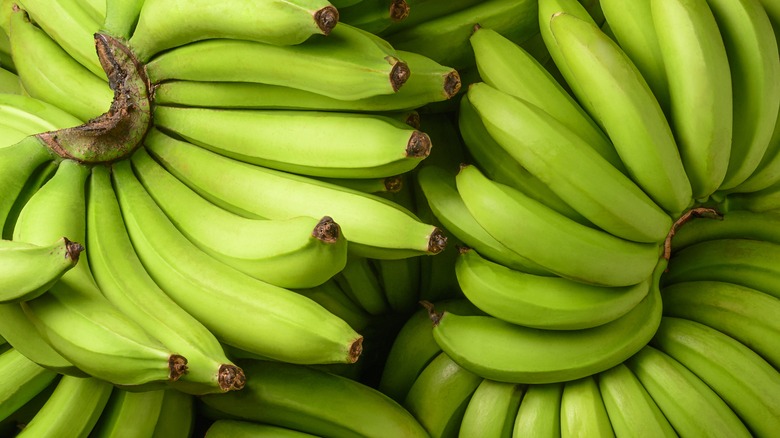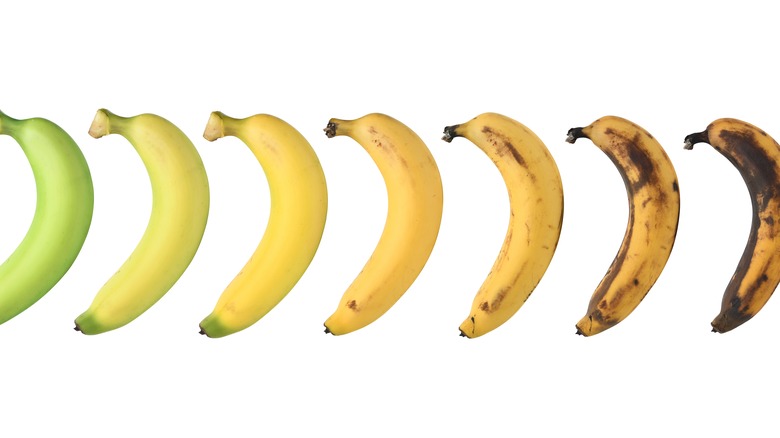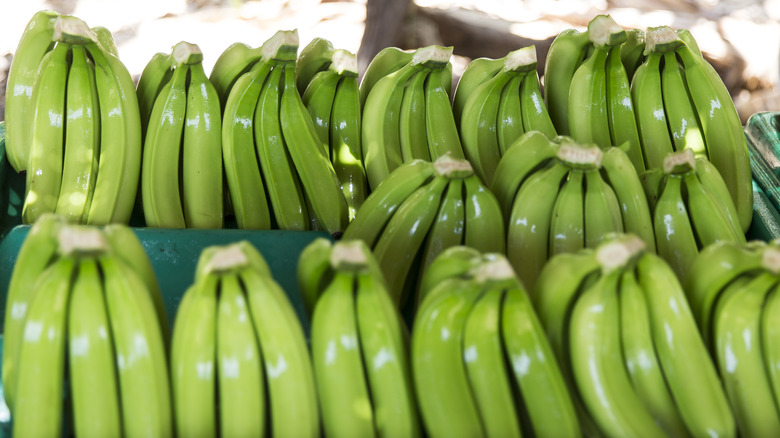Is It Safe To Eat Green Bananas?
"It's just a phase" isn't only applicable to punky teenagers in coming-of-age films — it also applies to bananas. Much like avocados, the texture and taste of bananas constantly change before and throughout their entire shelf life. From the starkest of green hues to yellow-bodied bunches, the fruit can change quickly from one day to the next, especially if you use a hack to ripen bananas.
If you ask someone what a banana generally looks like, they'll probably say something like a yellow crescent. But truthfully, it's impossible to pin down one static characteristic of a banana. Bananas contain a diverse range of flavors which change the longer they sit on your counter. And with over 1,000 different species of bananas out there — including one with blue skin — the options are endless, as noted by PBS News Hour.
Versatility in any fruit usually means consumers have varying preferences for how they like to eat it. But if you like the fruit when it's green, you're almost certainly in the minority: A YouGov survey showed that only 5% of respondents preferred them that way. Let's get into each of the ripeness stages of this variety.
The many stages (and phases) of bananas
According to Greatist, a Cavendish banana — the type most typically found in U.S. grocery stores — has five main stages of ripeness. Underripe and barely ripe are the first two. These bananas will be mostly green and firm to the touch. Next comes arguably the most popular stage: the ripe banana. This banana is easy to peel and has that familiar yellow shade in color. The fourth stage of ripeness is very-ripe. Here, the fruit retains its yellowness but takes on some brown spots and is much softer. Finally, the last stage for a banana is overripe, when the banana is mushy and brown — but luckily, there are several delicious uses for overripe bananas. (It's also the perfect stage and the perfect time to make banana bread.)
You are most likely familiar with these stages, but maybe not all of the flavors. To debunk some myths about green bananas, let's go back to the first stage. The makeup of the underripe fruit is much different. Healthline reports that green bananas are made primarily of starch, normally around 70% to 80%. Compare this to a ripe one with 1% starch, per The Epoch Times. Much of this starch is considered dietary fiber and creates a firm texture. So, what does this lofty carb content mean for green banana stans?
The truth about green bananas
Green bananas are perfectly safe to eat, but there are a few things you should think about before you go straight for the peel. You might not like the taste, as underripe fruit has a much different flavor than ripe ones — they are usually bitter rather than sweet. Because of this, most people use green bananas in recipes instead of choosing to eat them alone. However, Healthline reports that some people may have experienced discomfort like bloating, constipation, or gas after eating them.
Now let's consider the positives. Underripe bananas bring good bacteria to your gut, are rich in fiber, and can even help control blood sugar with their resistant starch and pectin levels. Because of this, the verdict is that green bananas are not only edible but also pretty good for you. Even if the taste isn't for everybody, its many benefits can help build up a healthy, strong gut biome, The Epoch Times claims.


